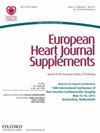The point on the treatment of arrhythmic storm
IF 1.7
4区 医学
Q3 CARDIAC & CARDIOVASCULAR SYSTEMS
引用次数: 0
Abstract
Arrhythmic storm is a clinical emergency associated with high mortality, which requires multi-disciplinary management. Reprogramming of the implantable cardiac defibrillator (ICD) aimed at reducing shocks, adrenergic blockade using beta-blockers, sedation/anxiolysis, and blockade of the stellate ganglion represent the first simple and effective manoeuvres, but further suppression of arrhythmias with antiarrhythmics is often required. A low-risk patient (e.g. monomorphic ventricular tachycardia, functioning ICD, and haemodynamically stable) should be managed with a beta-blocker (possibly non-selective) plus amiodarone, in addition to sedation with a benzodiazepine or dexmedetomidine; in patients at greater risk (high burden and haemodynamic instability), autonomic modulation with blockade of the stellate ganglion and the addition of a second antiarrhythmic (lidocaine) should be considered. In patients refractory to these measures, with advanced heart failure, general anaesthesia with intubation and the establishment of a haemodynamic circulatory support should be considered. Ablation, performed early, appears to be superior in terms of mortality and reduction of future shocks compared with titration of antiarrhythmics.心律失常风暴的治疗要点
心律失常风暴是一种与高死亡率相关的临床急症,需要多学科管理。对植入式心脏除颤器(ICD)进行重新编程以减少冲击、使用β-受体阻滞剂阻断肾上腺素、镇静/抗焦虑以及阻断星状神经节,这些都是简单有效的初步措施,但通常还需要使用抗心律失常药物进一步抑制心律失常。对于低风险患者(如单形室性心动过速、ICD 功能正常、血流动力学稳定),除了使用苯二氮卓类药物或右美托咪定镇静外,还应使用β-受体阻滞剂(可能是非选择性的)加胺碘酮;对于高风险患者(高负担和血流动力学不稳定),应考虑通过阻滞星状神经节来调节自律神经,并使用第二种抗心律失常药物(利多卡因)。对这些措施无效的晚期心力衰竭患者,应考虑进行插管全身麻醉,并建立血流动力学循环支持。与滴定抗心律失常药物相比,早期进行消融治疗在降低死亡率和减少未来电击方面似乎更有优势。
本文章由计算机程序翻译,如有差异,请以英文原文为准。
求助全文
约1分钟内获得全文
求助全文
来源期刊

European Heart Journal Supplements
医学-心血管系统
CiteScore
3.00
自引率
0.00%
发文量
575
审稿时长
12 months
期刊介绍:
The European Heart Journal Supplements (EHJs) is a long standing member of the ESC Journal Family that serves as a publication medium for supplemental issues of the flagship European Heart Journal. Traditionally EHJs published a broad range of articles from symposia to special issues on specific topics of interest.
The Editor-in-Chief, Professor Roberto Ferrari, together with his team of eminent Associate Editors: Professor Francisco Fernández-Avilés, Professors Jeroen Bax, Michael Böhm, Frank Ruschitzka, and Thomas Lüscher from the European Heart Journal, has implemented a change of focus for the journal. This entirely refreshed version of the European Heart Journal Supplements now bears the subtitle the Heart of the Matter to give recognition to the focus the journal now has.
The EHJs – the Heart of the Matter intends to offer a dedicated, scientific space for the ESC, Institutions, National and Affiliate Societies, Associations, Working Groups and Councils to disseminate their important successes globally.
 求助内容:
求助内容: 应助结果提醒方式:
应助结果提醒方式:


